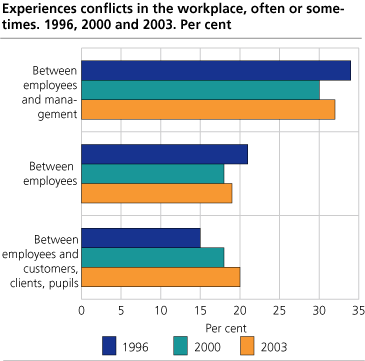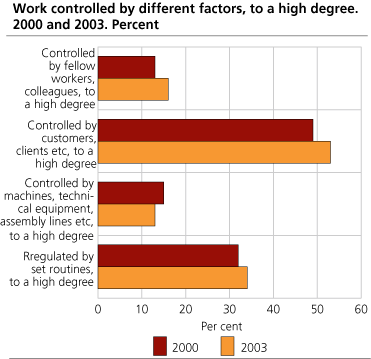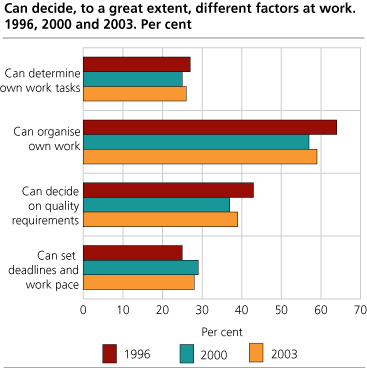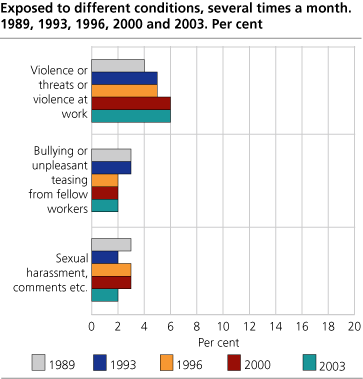Content
Published:
This is an archived release.
More people afraid of losing their jobs
Over the past three years the number of employees who feel at risk of losing their job has increased. In addition, more employees experience conflicts with customers and feel less in control of their work.
Two in ten afraid of losing their job
In 2001 one in ten reported this, in 2003 two in ten. The growth in unemployment in the same period can be an explanation. The number of unemployed people has increased from 3,6 per cent in 2000 to 4,6 per cent in 2003 shows results from the Labour Force Survey. ( http://www.ssb.no/emner/06/01/akumnd/tab-2004-06-02-01.html ). At the same time temporary employment is on a low and stable level, about one in ten. Nine in ten has a written work contract.
From 1996 to 2003 it has been a decrease in the number of employees with fixed salary. In 1996 nine in ten had fixed salary, in 2003 about seven in ten had fixed salary. The number of employees content with their salary has been relatively stable in the same period of time.
More people experience conflicts with customers/clients/pupils ...
In 1996 15 per cent of all employees said they experienced conflicts with customers/clients/pupils. In 2003 20 per cent said the same. Women experience this to a higher degree than men. In 2003 this is an equal big problem as conflicts between employees.
... but still more conflicts with management
Tree in ten says they often or sometimes experience conflicts between management and employees. Other factors suggesting that many people experience conflicts with management is the large number of employees that is met with hostility if they present critical remarks on working conditions. One in ten says they are met with hostility from colleagues.
Clients control young women's work
The pressure employed people experience working with customers/clients/pupils is evident in other areas of the survey as well. The portion of employed people that say their work is controlled by customers/clients/pupils to a high degree was 49 per cent in 2000 and 53 per cent in 2003. Especially young women's work is controlled by customers/clients/pupils: almost seven in ten women aged 16-24 years. Work is also controlled by other factors. An increasing portion of employees says colleagues control work.
Increased possibilities for professional development
Despite the fact that it looks like the possibility to decide upon own work has decreased in some areas, other more positive factors is also evident in the survey. It has been a steady increase in the portion of employed people who state they have good opportunities for professional development and to participate in further education. We can se a small increase and stabilization in the portion who state they have good opportunities to use education and work experience.
Low increase in violence and threats of violence at work the last 15 years
6 per cent say they have been exposed to violence or threats of violence at work once a month or more often. 15 years ago 4 per cent stated the same. The portion exposed to bullying or unpleasant teasing from fellow workers has remained on a stable and low level the last 15 years, as can be said on sexual harassment.
Women are twice as likely to be exposed to violence or threats of violence at work than men and four times as likely to be exposed to sexual harassment.
Stable physical work environment
There have been very small changes in the physical working environment from 1996 to 2003. Apart from indoor climate it is reasonable to say that relatively few employed people are exposed to these types of working condition problems.
There have been very small changes in ergonomic strain as well. Over half of all employed people must stand or walk most of the time at work, 36 per cent work with repeated or monotonous movements most of the time, 22 per cent say they have high risk of strain injuries. More women than men state that they have high risk of strain injuries.
This is some of the results from the Survey of Living Conditions 2003 about working environment. For more information on different subjects and tables, take a look at StatBank Norway .
Tables:
- Table 1 Survey of Living Conditions 1996-2003. Working environment. Physical work environment, by age groups. 2003. Per cent
- Table 2 Survey of Living Conditions 1996-2003. Working environment. Physical work environment, by sex and age groups, men. 2003. Per cent
- Table 3 Survey of Living Conditions 1996-2003. Working environment. Physical work environment, by sex and age groups, women. 2003. Per cent
- Table 4 Survey of Living Conditions 1996-2003. Working environment. Autonomy, variation and concentration, by age groups. 2003. Per cent
- Table 5 Survey of Living Conditions 1996-2003. Working environment. Autonomy, variation and concentration, by sex and age groups, men. 2003. Per cent
- Table 6 Survey of Living Conditions 1996-2003. Working environment. Autonomy, variation and concentration, by sex and age groups, women. 2003. Per cent
- Table 7 Survey of Living Conditions 1996-2003. Working environment. Relations, conflicts, violence and harassment, by age groups. 2003. Per cent
- Table 8 urvey of Living Conditions 1996-2003. Working environment. Relations, conflicts, violence and harassment, by sex and age groups, men. 2003. Per cent
- Table 9 Survey of Living Conditions 1996-2003. Working environment. Relations, conflicts, violence and harassment, by sex and age groups, women. 2003. Per cent
- Table 10 Survey of Living Conditions 1996-2003. Working environment. Working time, attatchment to the workplace and opportunitys for development, by age groups. 2003. Per cent
- Table 11 Survey of Living Conditions 1996-2003. Working environment. Working time, attatchment to the workplace and opportunitys for development, by sex and age groups, men. 2003. Per cent
- Table 12 Survey of Living Conditions 1996-2003. Working environment. Working time, attatchment to the workplace and opportunitys for development, by sex and age groups, women. 2003. Per cent
- Table 13 Survey of Living Conditions 1996-2003. Working environment. Work related health issues, industrial accidents and absence due to illness among employers, by age groups. 2003. Per cent
- Table 14 Survey of Living Conditions 1996-2003. Working environment. Work related health issues, industrial accidents and absence due to illness among employers, by sex and age groups, men. 2003. Per cent
- Table 15 Survey of Living Conditions 1996-2003. Working environment. Work related health issues, industrial accidents and absence due to illness among employers, by sex and age groups, women. 2003. Per cent
Contact
-
Mari Lande With
E-mail: mari.lande.with@ssb.no
tel.: (+47) 98 43 36 65
-
Håvard Bergesen Dalen
E-mail: havard.dalen@ssb.no
tel.: (+47) 40 90 23 50




